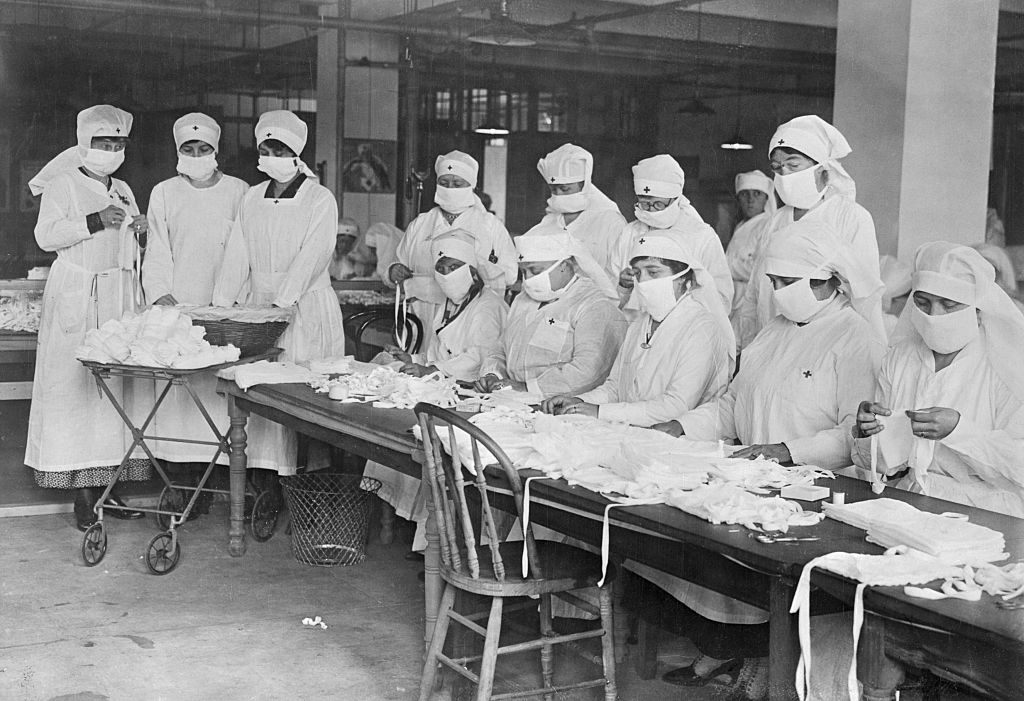People Hated Masks During the Last Pandemic Too

I don’t have much to say about Rusty Reno abruptly going supernova on Twitter this week. And given that Reno himself deleted his tweets, then deleted his Twitter account, then stopped publishing dream journals of his 75-mile walks around New York City, I think we can safely put any accusations of cowardice to bed.
What interests me more is the general fight over the use of masks. And it isn’t much of a fight: according to Gallup, 71 percent of Americans think the president and vice president ought to wear masks while traveling, including a decisive majority of Republicans. That’s a remarkable degree of consensus at a time of stark divisions, even if people aren’t always following their own advice. Still, the mask has nonetheless become a wedge in the culture war, an emblem of solidarity for those who believe the lockdowns must go on, a symbol of repression for those who want them to end. This has elicited a good deal of hand-wringing from pundits. How did we become so divided? How did masks become so controversial?
While these are good questions, it’s worth pointing out that masks were a source of contention during the last major American pandemic too. The most notable instances of this came in San Francisco. In the autumn of 1918—the Spanish flu’s deadliest season in the States—the city issued an order that everyone wear masks. And by January, a small group of dedicated dissenters had decided they’d had enough. Kiona N. Smith writes at Forbes:
The Anti-Mask League, as the group called itself, eventually presented a petition to the Board of Supervisors, demanding the repeal of the mask ordinance. San Francisco lifted its mask order on February 1, 1919, just 4 days after the Anti-Mask League presented its petition – but also around the time the second wave of influenza was beginning to taper off. And in hindsight, it’s hard to know quite what to make of the Anti-Mask League.
Its members accounted for less than 1% of San Francisco’s population at the time – perhaps 4,000 people out of around 500,000. Ironically, that’s close to the same number of people who died of the 1918 influenza outbreak in the city. So the Anti-Mask League wasn’t exactly a large grassroots movement, but its members included doctors and at least one elected city official. And at the time, even California’s state Board of Health was arguing that flimsy gauze masks were probably ineffective anyway.
The San Francisco Chronicle has more on the mask brouhaha. After the order was issued, the city’s authorities quickly turned abusive, arresting men for merely lowering their masks to their chins while they smoked pipes. This fueled a backlash. The Chronicle recalls one episode where a blacksmith not wearing a mask attacked a health inspector, only to find himself on the wrong end of a revolver.
Then there’s this priceless excerpt from a 1918 Chronicle article:
“John Raggi, arrested on Columbus Avenue, said he did not wear a mask because he did not believe in masks or ordinances, or even jail,” The Chronicle reported. “He now has no occasion to disbelieve in jails. He is in the city prison.”
Research the Spanish flu long enough and the parallels to today become striking: strife over masks, a sluggish federal response, desperate DIY cures. That isn’t to say that history repeats itself or that 1918 provides an easy roadmap for 2020. But it’s helpful to remember that, for all our supposed social and technological progress, human nature remains essentially the same. We’re still susceptible to groupthink, disquiet, querulousness. We’re still willing to sacrifice, but only for so long, especially if it’s affecting our bottom lines. These times are fraught, but not uniquely so. Take away Donald Trump and MSNBC, and we’d still be feuding over facewear and Dr. Fauci. Such as it is in a rowdy country of 330 million people. It’s both unsurprising that things are now coming apart and creditable that they haven’t come apart more.
Near the end of Graham Greene’s novel Our Man in Havana, Beatrice says, “I can’t believe in anything bigger than a home, or anything vaguer than a human being.” That’s a dark message but also a familiar one, and applicable in perhaps a less cynical sense to a pandemic. With mass death looming, all the idealisms and ideologies fall away. All that’s left to work with is mere man.
Comments